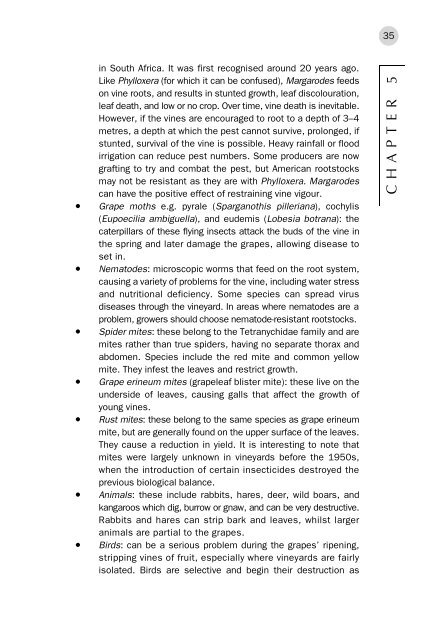Wine Production : Vine to Bottle - Vinum Vine
Wine Production : Vine to Bottle - Vinum Vine
Wine Production : Vine to Bottle - Vinum Vine
You also want an ePaper? Increase the reach of your titles
YUMPU automatically turns print PDFs into web optimized ePapers that Google loves.
35<br />
in South Africa. It was first recognised around 20 years ago.<br />
Like Phylloxera (for which it can be confused), Margarodes feeds<br />
on vine roots, and results in stunted growth, leaf discolouration,<br />
leaf death, and low or no crop. Over time, vine death is inevitable.<br />
However, if the vines are encouraged <strong>to</strong> root <strong>to</strong> a depth of 3–4<br />
metres, a depth at which the pest cannot survive, prolonged, if<br />
stunted, survival of the vine is possible. Heavy rainfall or flood<br />
irrigation can reduce pest numbers. Some producers are now<br />
grafting <strong>to</strong> try and combat the pest, but American roots<strong>to</strong>cks<br />
may not be resistant as they are with Phylloxera. Margarodes<br />
can have the positive effect of restraining vine vigour.<br />
• Grape moths e.g. pyrale (Sparganothis pilleriana), cochylis<br />
(Eupoecilia ambiguella), and eudemis (Lobesia botrana): the<br />
caterpillars of these flying insects attack the buds of the vine in<br />
the spring and later damage the grapes, allowing disease <strong>to</strong><br />
set in.<br />
• Nema<strong>to</strong>des: microscopic worms that feed on the root system,<br />
causing a variety of problems for the vine, including water stress<br />
and nutritional deficiency. Some species can spread virus<br />
diseases through the vineyard. In areas where nema<strong>to</strong>des are a<br />
problem, growers should choose nema<strong>to</strong>de-resistant roots<strong>to</strong>cks.<br />
• Spider mites: these belong <strong>to</strong> the Tetranychidae family and are<br />
mites rather than true spiders, having no separate thorax and<br />
abdomen. Species include the red mite and common yellow<br />
mite. They infest the leaves and restrict growth.<br />
• Grape erineum mites (grapeleaf blister mite): these live on the<br />
underside of leaves, causing galls that affect the growth of<br />
young vines.<br />
• Rust mites: these belong <strong>to</strong> the same species as grape erineum<br />
mite, but are generally found on the upper surface of the leaves.<br />
They cause a reduction in yield. It is interesting <strong>to</strong> note that<br />
mites were largely unknown in vineyards before the 1950s,<br />
when the introduction of certain insecticides destroyed the<br />
previous biological balance.<br />
• Animals: these include rabbits, hares, deer, wild boars, and<br />
kangaroos which dig, burrow or gnaw, and can be very destructive.<br />
Rabbits and hares can strip bark and leaves, whilst larger<br />
animals are partial <strong>to</strong> the grapes.<br />
• Birds: can be a serious problem during the grapes’ ripening,<br />
stripping vines of fruit, especially where vineyards are fairly<br />
isolated. Birds are selective and begin their destruction as<br />
CHAPTER 5
















